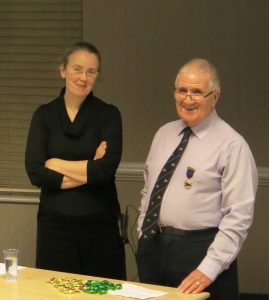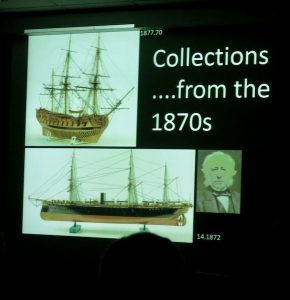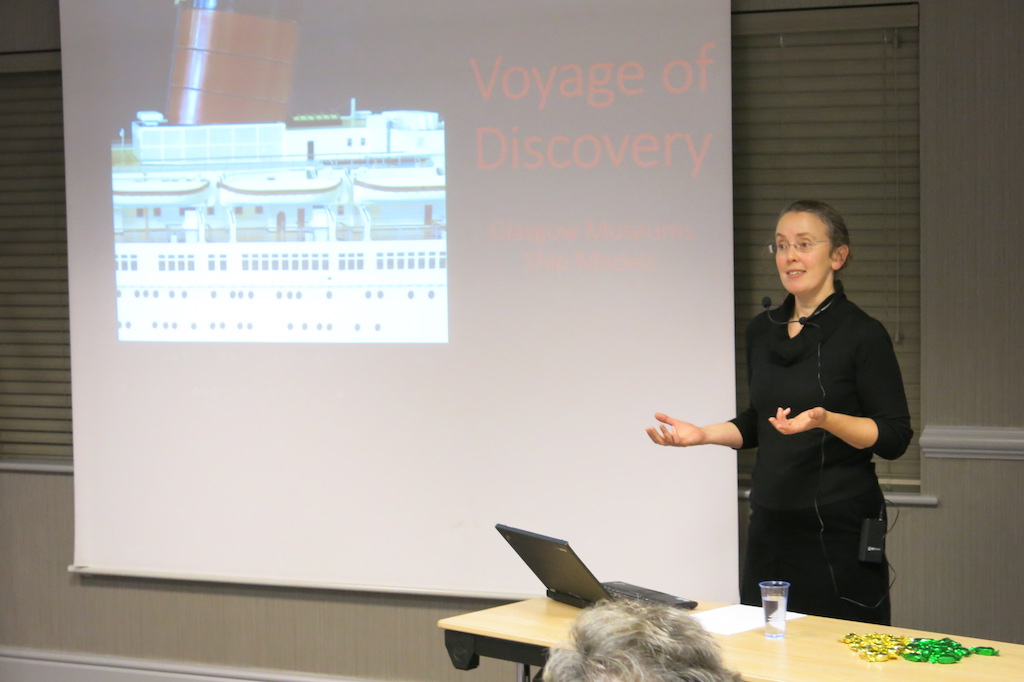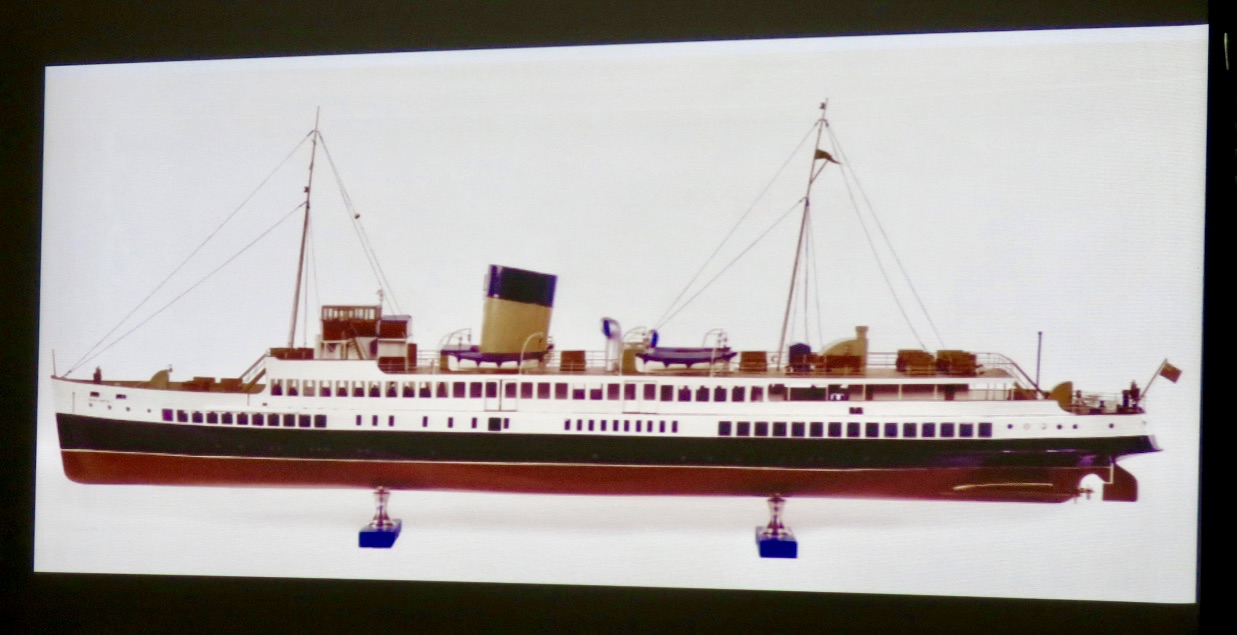
On of the most celebrated models in the City of Glasgow collection is PS Glen Sannox, built in 1892 for the Glasgow & South Western Railway’s Ardrossan-Arran service. The model, apparently made from the design specification before the ship entered service, shows a spar deck aft that was never actually fitted to the ship. The model was exhibited in Chicago in 1893. Copyright photograph, reproduced by courtesy of Glasgow Life
Museum curators don’t normally top the list of ‘must have’ guest speakers, but CRSC had received a tip-off that Emily Malcolm was no ordinary curator. The large number of members who turned out for her presentation on a mild November evening must also have had an inkling that we were going to be entertained. They were not disappointed, reports Stuart Craig.

Emily Malcolm was introduced to the meeting by CRSC President Roy Paterson. Her presentation was both enlightening and entertaining — there were as many laughs as gasps of delight
Emily is curator for the Transport and Technology exhibits at Glasgow’s museums. Dividing her time between the Nitshill Resource Centre and the Riverside Museum in Glasgow, she is well placed to keep an eye on all 672 ship models in the city’s collection.
Throughout her illuminating talk, she demonstrated that not only does she curate very enthusiastically, but she knows her Clyde steamers too.
As part of her presentation Emily was keen for “you enthusiasts to do some work too”. When she asked us to raise our hands if any of us had been to see the models at Nitshill or Riverside, she was noticeably aghast at the forest of raised arms, while some of us looked around to see if there were any miscreants who hadn’t raised theirs.
The audience was enthralled by a kaleidoscope of stunning photographs of many of the models, from the earliest (Black Prince 1859) to the very latest (Loch Shira 2017). The images included many close-up shots which drew the eye to the stunning detail that embellishes many of the models.
The collection started in 1872, aided by the shipbuilder Robert Napier, and was first catalogued in 1957. The material was initially exhibited at the Art Galleries in Glasgow (now the Kelvingrove Museum) but much of it can now be found on a novelty conveyor belt display at Riverside.
Over the decades the Clyde’s leading shipyards had scale models built of their newly designed vessels in order to show their wares at exhibitions, and to demonstrate their designs to their clients. Half models were constructed to help clients see the interior of the designs.
Model making was taken very seriously. Skilled model makers, such as Edward Johnson who built for Dennys, and Messrs Kelso, who did likewise for Fairfields, were held in great esteem and furnished with generous facilities and staff.

An audience eye-view of one of the images in Emily Malcolm’s presentation, showing two models associated with the eminent 19th century shipbuilder Robert Napier, who helped found the Glasgow City collection
Many of their models were exhibited around the world in far-flung places such as Paris, Chicago and..…Kilmarnock. The shipping companies believed that “if the models were good the real ships must be good.”
Having held our attention so well with her photographic parade, Emily now “made us work” with her pictorial quiz — “Guess which steamer model”. On guessing correctly, each smart Alec was rewarded by a foil-wrapped toffee, which Emily either hurled through the air like Ian Botham, or rolled down the lecture theatre aisle with all the skill of a carpet bowler to the lucky recipient.
When the reply to the first photograph “Iona of 1855” issued from half way down the room, only half a second after the image had settled on the screen, Emily knew she had met her match. She was clearly taken aback by the knowledge of her audience, especially when some errors in the models were pointed out.
Emily resorted to trying to trick us by showing the same ship twice in different models (Jeanie Deans 1884)! That didn’t work either and she voiced her regret that she had not made the quiz more difficult “…I could have included some real corkers, you know.”
The correct answers kept coming, and the toffees kept flying through the air and along the floor. One clever-clog had so many correct guesses that his jaws were still trying to disentangle each other 10 minutes after the fun was over.
The main talk was followed by a lively question-and-answer session, and some fascinating facts emerged. Most of the models were made of pine. A controlled environment is maintained at the Nitshill storage facilities. The model of the 1892 Glen Sannox is Emily’s favourite.
An enthusiastic vote of thanks was given by our ‘reliable source’ Robert Cleary, and the audience, some still chewing, departed the room with smiles on their faces.
This was a very different kind of CRSC meeting: Emily deserves great credit for pitching her presentation so skilfully and illustrating it so beautifully.
My only regret, on this fun evening, was that despite working hard all evening, furiously scribbling notes for this report, I never got a sweetie!
For information about tours and opening hours at the Glasgow Museums Resource Centre at Nitshill, where most of the ship model collection is stored, click here.

Windsor Castle, a flush-decker built by Cairds of Greenock in 1859 and sold to India in 1860, was the first Clyde steamer to be made of steel. Photograph reproduced by courtesy of Glasgow Life

Close-up of HMS Argyll, built by Scotts in 1905. The model, made by Kelso’s, is full of fascinating detail, all perfectly proportioned, from boathooks and oars to davits and winches. Photograph reproduced by courtesy of Glasgow Life

A model of the two sister ships Hibernian and Norwegian, showing a cutaway section designed to reveal internal detail. Photograph reproduced by courtesy of Glasgow Life

Emily Malcolm had sweeties on the desk, ready for distribution to anyone who could identify the steamer models in her lively presentation
All images on the CRSC website are protected by copyright law. Please do not reproduce them on Facebook, Pinterest or any other public platform without first gaining written permission: info@crsc.org.uk
Not yet a member of CRSC? Membership starts from only £10 per year. Paid-up members receive CRSC’s 56-page colour magazine and the comprehensive annual Review of west coast shipping, plus discounts on special sailings, photos and DVDs, and a series of talks in Glasgow during the winter months. To join on-line today, click here.
Published on 17 November 2018












